
Stop overpaying - start transferring money with Ogvio. Join the waitlist & grab early Rewards NOW! 🎁
Phantom Wallet claims to be the go-to crypto wallet for navigating the Solana ecosystem and offers access to a wide range of DeFi opportunities. It promises a seamless, secure, and speedy cryptocurrency experience. To know whether these claims are backed by reality, let’s find out the truth behind the hype in this Phantom Wallet review.
You'll get to know some background information and then some advantages and disadvantages of using it. There will also be a step-by-step guide on how to use Phantom Wallet, from setting it up to performing some functionalities.
Before you continue reading this Phantom Wallet review, note that this is a software wallet, which means it might be less secure compared to hardware wallets like Ledger Nano X or Trezor Safe 5. A hardware wallet stores your private keys on a physical device, making it harder for hackers to access your funds.
Verdict at a glance: Phantom Wallet offers a user-friendly platform for managing crypto assets, with strong points in NFT integration. What makes this tool stand out is that it lets users swap and buy some cryptocurrencies directly from the wallet and provides users with control over their funds due to its non-custodial nature. However, consider its limitations, like strong reliance on Solana, limited networks, and potential for scams, before using it.
Pros
- Reliable security and privacy features
- Comprehensive asset management tools
- An NFT-friendly wallet
- Solana-focused ecosystem integration
- Buy, swap, and stake functionalities
Cons
- Limited to Solana ecosystem
- Potential for scams
Table of Contents
- 1. What is Phantom Wallet?
- 2. Phantom Wallet Review: PROS
- 2.1. Committed to Security and Privacy
- 2.2. Comprehensive Asset Management Tools
- 2.3. An NFT-Friendly Wallet
- 2.4. Solana Ecosystem Integration, and More!
- 2.5. Buy, Swap, and Stake Functionalities
- 3. Phantom Wallet Review: CONS
- 3.1. Focused on the Solana Ecosystem
- 3.2. Potential for Scams
- 4. Phantom Wallet Fees
- 5. How to Use Phantom Wallet?
- 5.1. How to Set Up Phantom Wallet?
- 5.2. How to Connect Phantom Wallet to an NFT Marketplace or dApp?
- 5.3. How to Swap and Buy Crypto on Phantom Wallet?
- 6. Conclusions
What is Phantom Wallet?
First thing first, in this Phantom Wallet review, let's define this tool and get to know the basic information. Phantom Wallet is a non-custodial cryptocurrency wallet designed to provide users with an easy-to-navigate platform to manage their digital assets, from sending and receiving cryptocurrencies to interacting with decentralized applications (dApps) and exploring the world of non-fungible tokens (NFTs).
A non-custodial or self-custodial means you, the user, have complete control over your private keys and assets[1]. This differs from custodial wallets that are built into exchanges like Binance and Bybit, where a third party, such as a cryptocurrency exchange, holds your private keys on your behalf. It’s good for security and control, but it requires a higher responsibility from the user.
At its core, Phantom works by generating unique digital keys for each user. These keys act as the user's digital identity, allowing them to securely manage and transact with their cryptocurrency holdings within the platform.
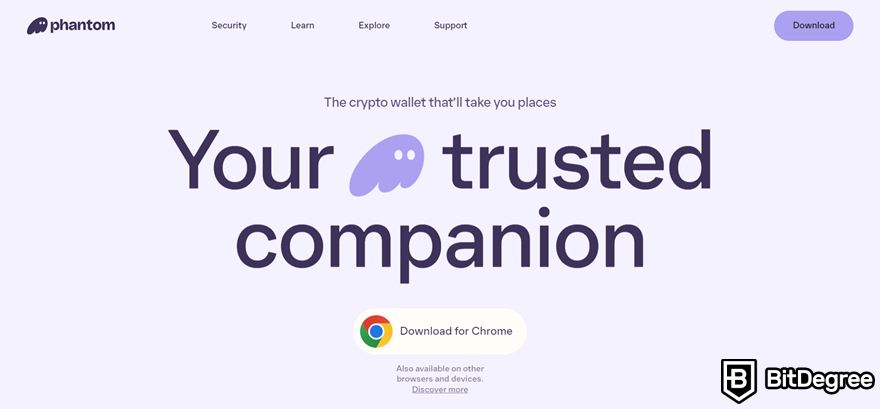
Besides being a non-custodial wallet, this tool is also multi-chain. While it initially was built and launched as a Solana-based tool in January 2021, it has branched out to support Ethereum, Bitcoin, and Polygon networks as well.
To streamline trading on the platform, the team introduced an in-app token exchange in June 2021. It lets users swap and buy cryptocurrencies available on the networks. Within just four months, trading volume on this feature surpassed $1 billion.
With all these seemingly enticing features, no wonder that it has 1.9 million monthly active users at the time of writing. Still, is it really a good option for you? Don’t worry. We’ll find an answer in this Phantom Wallet review together by going over its pros, cons, fees, and how to use this tool in general.
Phantom Wallet Review: PROS
From the previous section, you've known the answer to the question, “What is Phantom Wallet?” in general. Now, let’s uncover what makes it stand out among other crypto wallets in terms of its security, asset management functionality, network ecosystem, and purchasing features.
Committed to Security and Privacy
To keep its users safe, Phantom Wallet uses several security features. One of the cornerstones that I want to emphasize, which is a must-have feature in any crypto wallet, is seed phrase backup.
Phantom generates unique 12-24 word recovery phrases during wallet setup. These phrases act as the master key, allowing users to restore the wallet if they lose access. It's crucial to store these phrases offline to prevent unauthorized access and protect their funds.
To improve this standardized measure, Phantom provides an auto-lock timer that automatically locks your wallet app or extension after you seem to be inactive for a while, even for several minutes. This adds protection in case you forget to lock the app manually and someone has temporary access to your device.
If you use Phantom’s mobile app and your device has a Face ID setting, you can enable the feature and pick a timeframe that best suits your security preferences.
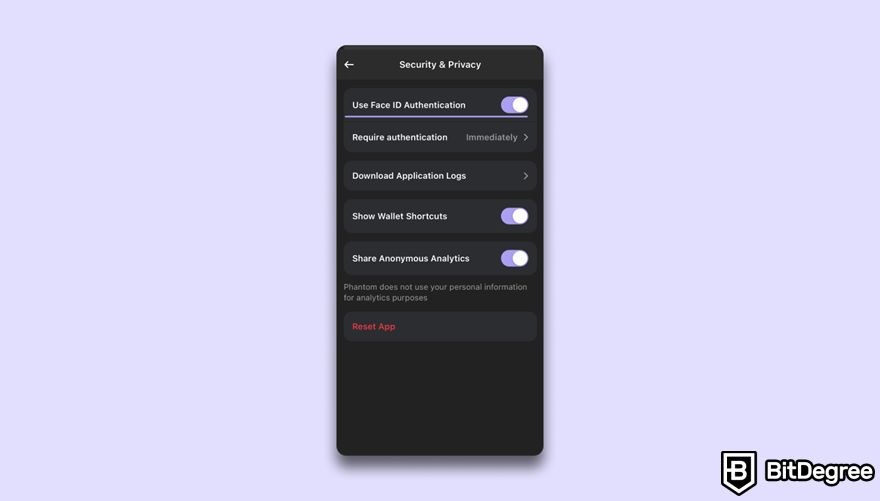
Another measure worth mentioning in this Phantom Wallet review is called "Transaction Previews,” which aims to shield users from digital threats, including phishing, domain hijacking, and malicious software. Acting like a digital guard, this feature scrutinizes every transaction before approval, flagging any suspicious activity and providing real-time alerts.
This feature analyzes various aspects of a transaction to identify potential risks, such as the domain, website, and involved tokens. Unlike traditional methods that rely on pre-determined blacklists, the system, with the help of artificial intelligence (AI), proactively scans for flashy activity without needing prior reports. If the system finds anything suspicious, it displays clear and easy-to-understand alerts so that you know exactly what's happening.
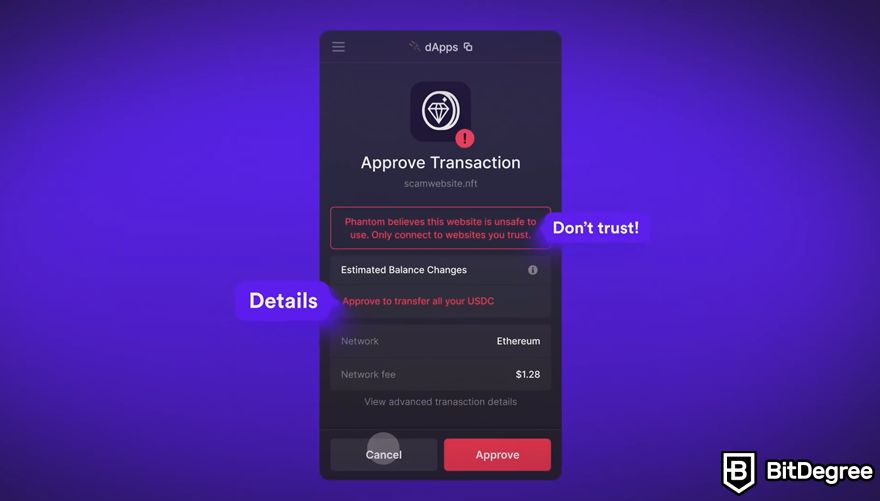
In addition to “Transaction Previews” that actively check malicious activities, this wallet has an open-source blocklist. When the team finds a malicious token or NFT, it adds the contact address and domain to the block list. Then, the feature hides the asset from the wallet and warns the user if they try to connect to the malicious site.
Like other hot crypto wallets, Phantom doesn’t require users to input their name, email address, or phone number to sign up.
If you feel the need to improve security, you can connect this tool with wallets from Ledger. This integration adds an extra layer of protection since your private keys are stored offline on the Ledger device, making it harder for hackers to access your funds.
To connect your Ledger, ensure it's plugged in or connected via Bluetooth, and the Phantom extension is open. Phantom then automatically detects your Ledger and guides you through selecting your accounts on supported networks. For each network, you need to open the corresponding app on your Ledger device.
After completing those steps, you're ready to go! Return to Phantom to see your funds.
Comprehensive Asset Management Tools
As a crypto wallet, Phantom offers a comprehensive asset management toolset that helps users effortlessly track and monitor their crypto holdings.
All your crypto tokens and coins are displayed on the main tab, but you have the flexibility to personalize the list and only show your preferred assets by clicking the toggle next to the token name.
You can also monitor all activity with detailed transaction history and notifications. This includes incoming and outgoing transactions, as well as any interactions with dApps. Don’t worry, Phantom Wallet doesn’t have a limit on tokens, balances, and transactions.
To organize your assets better, you can have multiple accounts to separate different purposes. For example, you use the first account to make transactions and the second for a storing purpose only to protect your funds. Moreover, this wallet lets users edit and personalize their accounts by adding a custom avatar and editing wallet account names.

In addition to creating new accounts, Phantom allows you to “compile” your crypto holdings by importing wallets from other platforms. You can seamlessly bring in your existing addresses from wallets like Coinbase Wallet or MetaMask without transferring your funds – no need to juggle different wallets.
Meanwhile, the collectibles have a different tab, which displays your NFTs in a visually appealing gallery. If you click on it and scroll down, you can see all the details about the asset and a button that enables you to send it to someone else.
Whenever you buy an NFT on a marketplace, the tool automatically lists the asset within Phantom whatever type of asset you purchase. Phantom supports a range of media types, including images, audio files, video files, and 3D models.
You can also use the search bar to find their collection and pin it by clicking on the three dots at the top right. The pinned ones appear at the top of the collectibles section.
An NFT-Friendly Wallet
This tool's commitment to being an NFT-friendly wallet doesn’t end in displaying, storing, and browsing it. In this Phantom Wallet review, I want to highlight that the platform lets users do more with their assets: trade, sell, mint, and burn.
First, you can easily connect your desktop Phantom with popular NFT marketplaces like OpenSea, MagicEden, and Blur.io, streamlining your NFT buying and trading experience.
Moreover, you can directly sell the asset using the "Instant Sell" feature on this wallet.
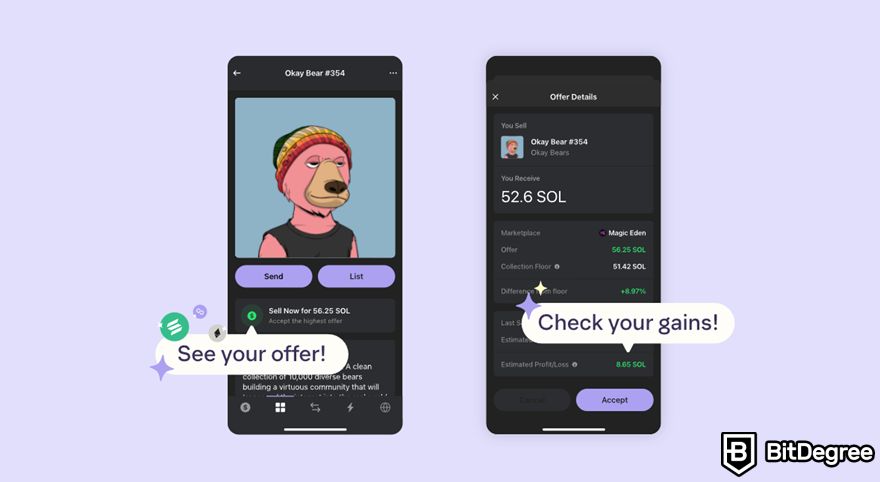
Whenever you get an offer, you see an "Instant Sell" banner consisting of the offer details, including the estimated profit/loss and fees, sorted by the highest bid. No need to waste time comparing prices on different marketplaces. With this feature, you only need to accept the offer to get paid right away.
Phantom brings your NFT experience further with "Shortcuts", a centralized hub for all your NFT-related information. Similar to Linktree (a popular link-in-bio platform), "Shortcuts" provides a consolidated space for important links associated with each NFT in your collection, including:
- Access to NFT project sites, social media, and chat groups.
- Actions like staking, voting, playing games, or tipping creators.
To ensure a safe experience and guarantee authenticity, all links within Phantom's "Shortcuts" are directly provided by the NFT project. For creators, this feature helps them engage with their community, while collectors can streamline their NFT searching as they can easily access relevant information and take actions related to the assets.

Beyond "Shortcuts" and facilitating transactions, do you know what is Phantom Wallet’s real kicker in terms of NFTs? It has "Quests" that offers a fun way to earn rewards for completing tasks, such as signing up for apps and trying out new features.
To perform "Quests", Phantom provides you with instant access to DRiP, the NFT drop platform that gifts free weekly Solana collectibles from top artists, creators, and influencers. DRiP also lets you discover and subscribe to creators, play a daily mini-game to upgrade your NFT rarity, and donate to your favorite creators.
Another activity you can do with Quests is using Camera Mint on Phantom Mobile, a feature that lets you transform photos and videos directly into Solana NFTs. It encourages users to turn special moments like a best friend’s wedding or grandma’s birthday into a collectible.
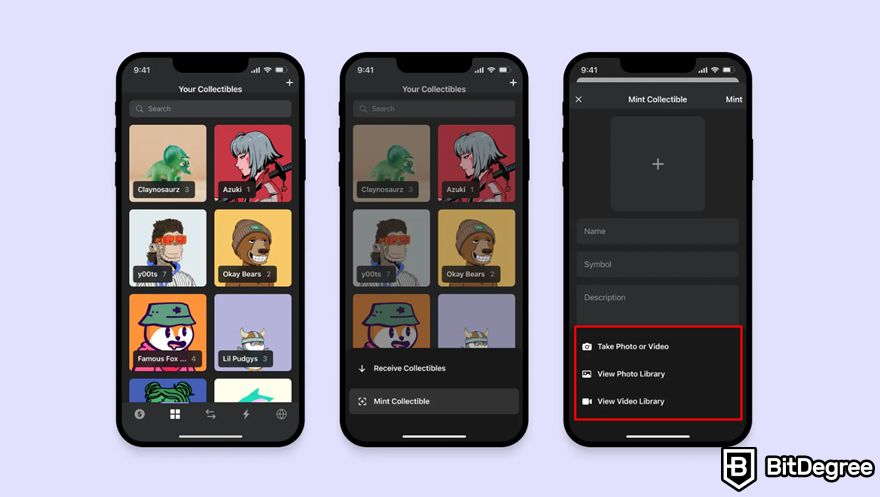
Not only do users get easier access to mint their NFTs, but they can also get a bonus (a commemorative Phantom collectible) for doing so.
Other than minting NFTs and facilitating transactions, users can report unwanted NFTs and automatically move them to the "Hidden" folder as spam, similar to email. The Phantom’s system then identifies the spam report and takes appropriate action.
Additionally, users can burn NFTs to permanently remove them from the wallet. If they do this, they earn SOL in return because they reclaim some of the SOL that a scammer spent on sending them an NFT in the first place.
Solana Ecosystem Integration, and More!
Solana, the backbone of Phantom, is known for its lightning-fast transaction speeds and minimal fees. This translates to near-instantaneous and cost-effective transfers for users.
With Solana’s strength, this tool can also offer a seamless user experience. For example, it can implement Solana sign-in that provides a quick and secure authentication method. Meanwhile, its access to Solana DeFi opens doors to decentralized financial opportunities, all facilitated by Phantom's integration with the Solana network.

In addition to its strong foundation on Solana, it now supports Ethereum, Bitcoin, and Polygon networks, providing users with a more versatile platform to manage their various digital assets.
This expansion allows users to access a wider range of decentralized applications and tokens across multiple blockchains without having to manually switch networks. They can also seamlessly access and trade on popular decentralized platforms like Uniswap and SushiSwap for token swaps or participate in yield farming opportunities on AAVE and Curve.
Buy, Swap, and Stake Functionalities
Many assets like tokens and NFTs are exclusive to their originating blockchain.
For instance, Ethereum hosts ETH and iconic NFTs like Bored Ape Yacht Club, while Solana is home to SOL and Claynosaurz. While some assets, such as stablecoins like USDC or USDT, exist across multiple blockchains, their underlying technology differs between chains.
To bridge the gap and improve asset liquidity, Phantom introduces the "Cross-Chain Swapper". This tool enables efficient and cost-effective token transfers between different blockchains – Bitcoin, Solana, Ethereum, and Polygon.
So, what is Phantom Wallet’s list of supported tokens? Well, it lets you swap any token on the origination chain for USDC on the destination chain. It also supports USDT, DAI, and WETH as the destination chain token for particular routes.

Moreover, the tool allows you to Refuel, meaning you can transact as soon as you bridge. A portion of the transferred funds is automatically converted into the native token, removing the inconvenience of running out of gas fees on the destinated network.
If you want to get the best deal, choose “Best Return” or “Fastest” transfer based on your needs. Bridges typically take anywhere from a few minutes to an hour, depending on network congestion and other factors, such as transaction fees and the specific blockchains involved.
You can check the estimated transaction time and cost for each bridge option and get updated on the transaction status.
Besides swapping tokens on those blockchains, Phantom lets users buy assets directly. This wallet partners with third parties, like Coinbase Pay, MoonPay, and Robinhood, to allow you to make a crypto purchase using fiat.
However, the range of available cryptocurrencies for direct purchase is limited compared to traditional exchanges like Binance and Bybit. These platforms offer a significantly wider selection, with Binance supporting over 500 and Bybit exceeding 1,400 cryptocurrencies.
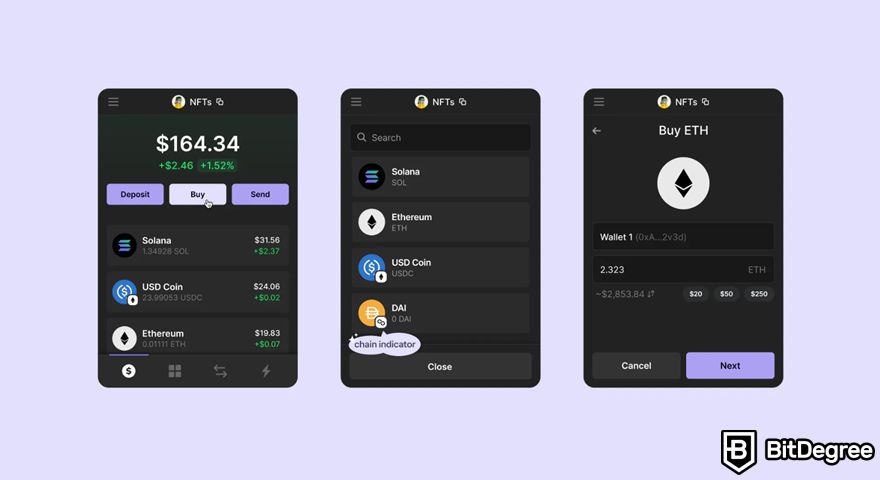
To further help you generate more income within the wallet, Phantom enables users to stake SOL and ETH. Staking involves temporarily locking up a portion of a user's cryptocurrency as a contribution to the blockchain's operations[2].
Phantom provides direct staking for SOL and liquid staking for SOL using Jito and ETH using Rocket Pool. Direct staking means locking up your SOL to directly support the Solana network and earn staking rewards, while liquid staking involves staking your SOL or ETH to receive a derivative token that can be used for trading and other DeFi activities while still earning staking rewards.

Did you know?
All Crypto wallets may look similar to you but they're NOT all the same!
Phantom Wallet Review: CONS
In this section of the Phantom Wallet review, let's explore some potential drawbacks to help you consider its limitations for a more informed decision.
Focused on the Solana Ecosystem
What is Phantom Wallet’s core drawback? I think it's its reliance on Solana. While Phantom has tried to expand its ecosystem beyond Solana by integrating support for Ethereum and Polygon, its primary strengths and development focus remain closely tied to the Solana blockchain.
This specialization, while beneficial for Solana users, may create a less comprehensive experience for those primarily engaged with other networks. For example, users accustomed to a wider range of features or deeper integrations on Ethereum-based wallets may find Phantom's offerings more limited in comparison.
This focus on Solana may also lead to a gap in further development and support compared to other chains. Although the wallet has expanded its capabilities, I’m afraid that the core functionalities and optimizations might be prioritized for Solana-based applications.
Potential for Scams
In the earlier part of this Phantom Wallet review, I mentioned that this tool has robust security features to create a safe experience for users.
However, some user Phantom Wallet reviews mentioned that they experienced a phishing attempt right after connecting the wallet to an NFT marketplace.
Of course, this type of attack can happen in any wallet, but I think it’s important to approach the platform with caution.
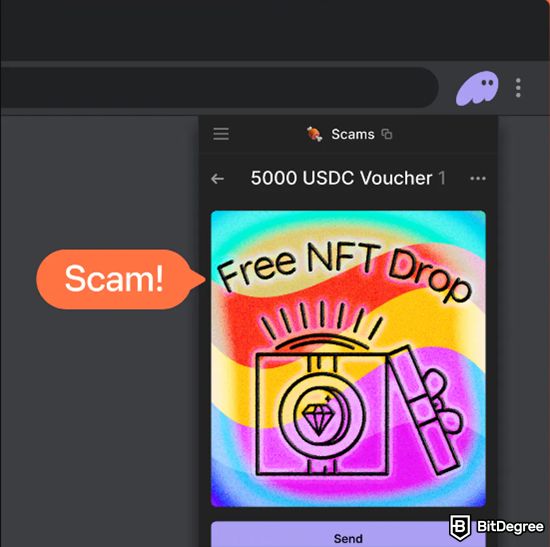
From the Phantom’s side, it’s willing to help its global users by providing an automated assistant, a comprehensive help center, and access to human agents via ticket. The team is dedicated to answering any question related to token swaps, hardware wallet issues, troubles with dApps, and other general questions about the wallet.
Nonetheless, despite Phantom’s commitment to combating phishing and scams, a proactive approach from users themselves remains crucial. Incidents of phishing attacks, though not exclusive to Phantom, highlight the importance of being cautious when interacting with external platforms.
Phantom Wallet Fees
Up to this point in my Phantom Wallet review, I’ve highlighted its strengths and weaknesses. However, to fully assess its value and know whether this wallet is the right option for you, understanding the associated costs is crucial. Budgeting and deciding if Phantom aligns with your financial goals requires clarity on fees!
So, what is Phantom Wallet’s fee structure? This wallet is generally free to use. However, you may incur fees when interacting with external platforms, such as token swaps facilitated through the wallet.
Fees for using the Cross-Chain Swapper depend on the tokens involved, but you typically pay two types of fees:
- Transaction fee. This covers the cost of processing the transaction on the destination blockchain and is paid in the original token. The fee varies by chain and isn't linked to the transfer amount.
- Bridge provider fee. A small percentage (usually around 0.3%) of the transferred amount is charged by the bridge service.
While these fees can fluctuate, Phantom always provides transparent cost estimates upfront, ensuring no hidden surprises. Note that Phantom isn't liable for charges imposed by third-party services.
How to Use Phantom Wallet?
After weighing the pros, cons, and fees discussed in this Phantom Wallet review, are you interested in using it as your primary crypto wallet?
If so, let's figure out how to use Phantom Wallet in this section, from setting it up, connecting it with an NFT marketplace or dApp, and swapping or buying cryptocurrencies directly from the platform.
How to Set Up Phantom Wallet?
You can set up this wallet on both desktop and mobile devices as it has an app that is available on Google Play and App Store.
In this Phantom Wallet review, I'll show you how to do it on a desktop:
Step 1: Download the extension by visiting its official website and clicking the “Download” button in the upper right corner.
Step 2: Choose your browser and click on it. In this step, I picked Chrome, but you can select any option you prefer.
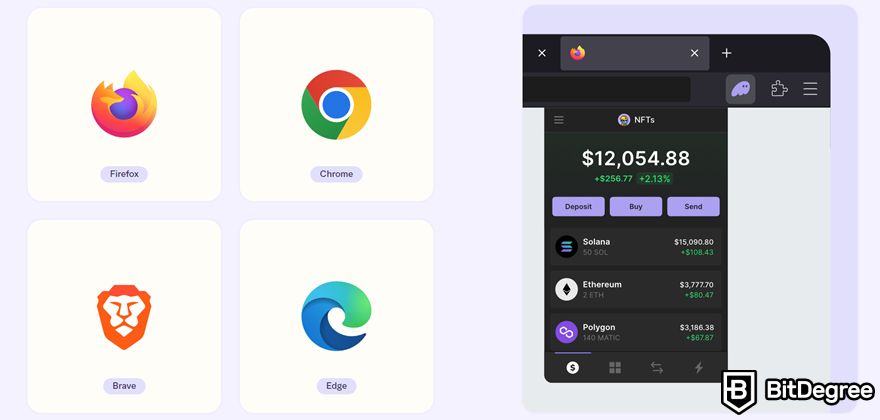
Step 3: Begin by selecting "Create a new wallet". If you already have a Phantom wallet, simply choose "Import an existing wallet". Don't worry, you can always import your wallet later.
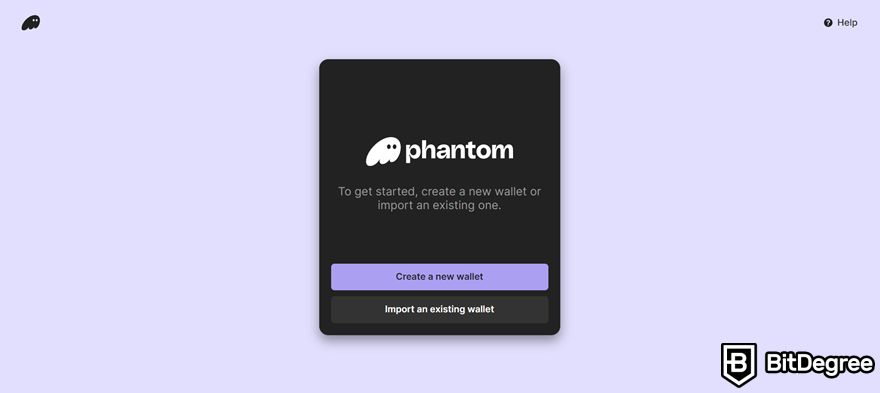
Step 4: Set a strong password. Make sure you create a memorable yet complex password, as you need it every time you want to access your Phantom Wallet.
Once you finish creating a password, you should see your secret recovery phrases. Store them securely since these are crucial for recovering your wallet if you lose access.
How to Connect Phantom Wallet to an NFT Marketplace or dApp?
To fully immerse yourself in the NFT ecosystem, you need to connect your Phantom wallet to your preferred marketplaces and dApps. I'll guide you through the simple process:
Step 1: Find a “Connect Wallet” or “Sign In” button on your selected marketplace or dApp.
Step 2: In most cases, you should see a pop-up window that allows you to select your wallet. Just select “Phantom” to connect. If you can’t find it, select “Metamask,” as it typically helps open your Phantom Wallet to connect.

Step 3: Verify your connection. To check whether you already did the process correctly, go to the account section of your NFT marketplace or view your profile. Generally, a connected wallet should be displayed.
How to Swap and Buy Crypto on Phantom Wallet?
From the earlier sections of this Phantom Wallet review, you know that this tool lets you swap tokens across Solana, Bitcoin, Ethereum, and Polygon. Follow these steps to use the Cross-Chain Swapper:
Step 1: Navigate to the swap tab by selecting the two-arrow icon at the bottom of the interface.
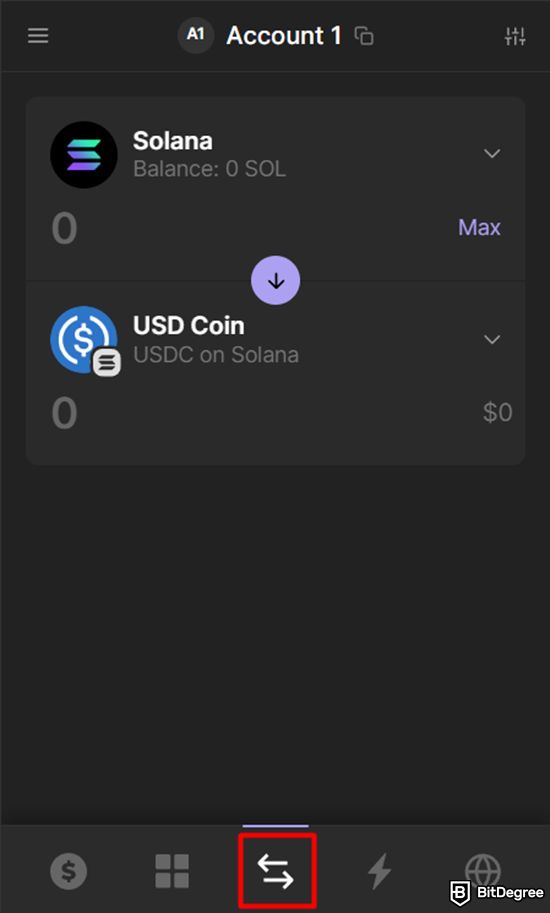
Step 2: Select the origination chain and token. Use the dropdown menu to explore your options or quickly find what you need by searching for the chain or token name. In this Phantom Wallet review, I chose Ethereum.
Step 3: Pick the destination chain and token. For illustration, I used USDC.

Step 4: Enter the amount and double-check the order to avoid errors. If everything looks good, click “Review Order” to proceed.
Step 5: Check the transaction details, including the networks and tokens you’re swapping, fees, and estimated time to complete the swapping process. Click “Swap” to confirm the transaction.
Besides swapping, you can buy cryptocurrencies! Let's learn how to use Phantom Wallet to purchase an asset:
Step 1: Open the Phantom Wallet extension on your browser or its app on your mobile device. Then, click the “Buy” button.

Step 2: Pick the token you want to buy and type in how much you would like to purchase. Alternatively, select one of the “quick buy” options with the provided amounts.

Step 3: Choose from available payment methods to proceed with your purchase. You can select Binance P2P trading, Apple Pay, credit/debit card, or Google Pay. Phantom partners' process payments and fees can change. Also, note that some payment options are exclusive to certain regions.
Follow the on-screen instructions to complete your transaction.

- User-friendly design
- Robust security
- Long battery life

- Dual auditable Secure Element chips
- Quantum-resistant protection
- Water and dust resistant

- Transaction Check feature
- Direct dApps connection
- Great middle-ground price
Conclusions
Now that we've covered essential aspects, it's time to wrap up this Phantom Wallet review.
Phantom Wallet presents itself as a user-friendly platform for managing cryptocurrencies, particularly within the Solana ecosystem. Its strengths lie in its intuitive interface, robust security, comprehensive asset management, diverse functionalities, and integration with NFT platforms.
While Phantom offers convenience, you may consider other options that offer more varied networks. It's also important to consider the potential security risks associated with software wallets.
Therefore, those prioritizing maximum security might consider hardware wallets from Ledger Nano X and Trezor Safe 5. These devices offer an extra layer of protection for your crypto assets by storing your private keys offline.
The content published on this website is not aimed to give any kind of financial, investment, trading, or any other form of advice. BitDegree.org does not endorse or suggest you to buy, sell or hold any kind of cryptocurrency. Before making financial investment decisions, do consult your financial advisor.
Scientific References
1. K. Shah, D. Lathiya, N. Lukhi, et al.: ‘A Systematic Review of Decentralized Finance Protocols’;
2. E. Toufaily: 'An Integrative Model of Trust Toward Crypto-Tokens Applications: A Customer Perspective Approach.'


